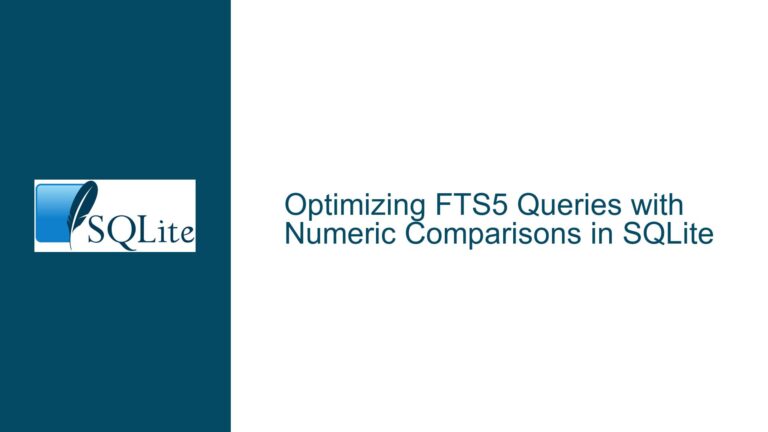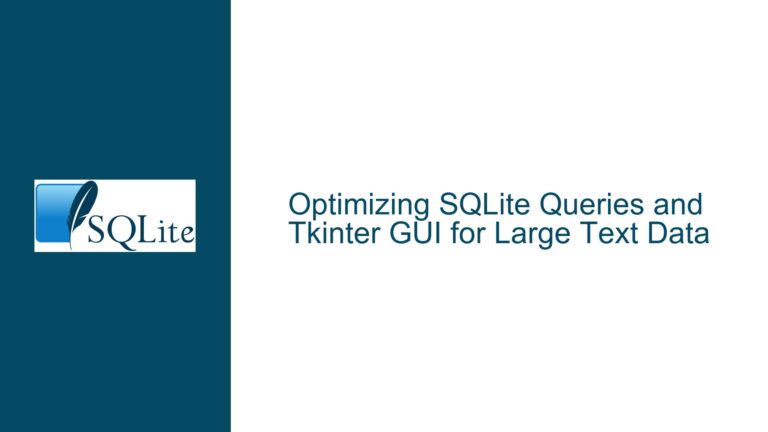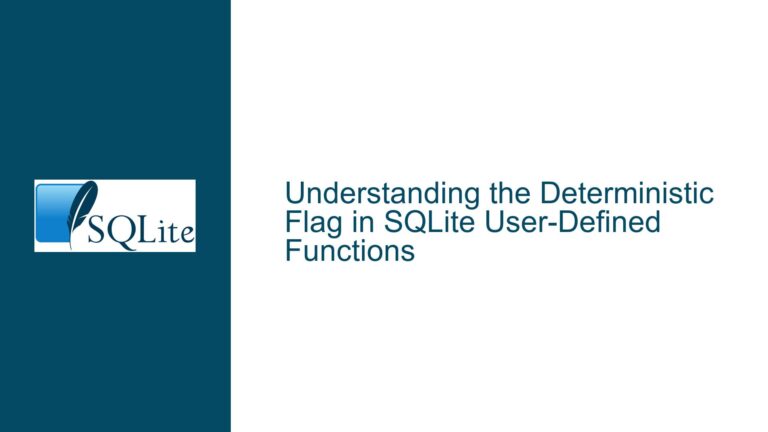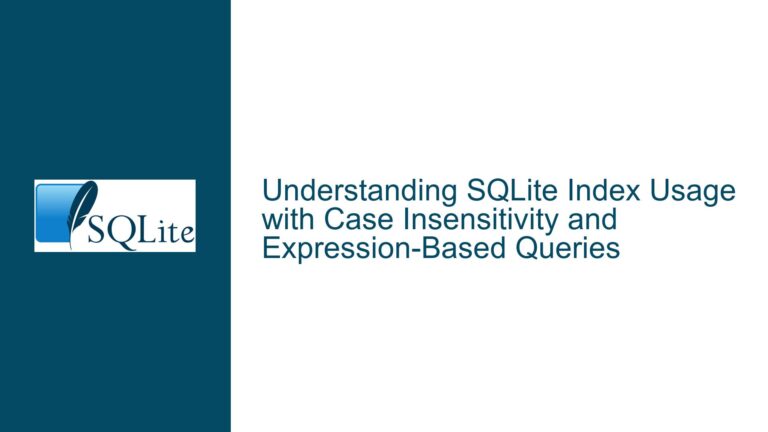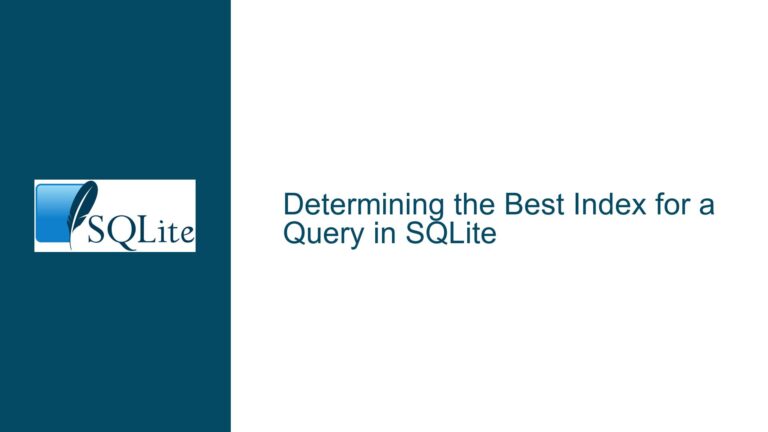SQLite Varint Encoding Optimization: Performance vs Implementation Trade-offs
Understanding SQLite’s Variable-Length Integer Storage Architecture
SQLite’s variable-length integer (varint) encoding system plays a crucial role in database performance and storage efficiency. The current implementation uses a variable-length encoding scheme where integers are stored using 1 to 9 bytes, depending on the magnitude of the value being stored. The encoding process takes the binary representation of an integer and breaks it into 7-bit chunks, using the most significant bit of each byte as a continuation flag.
The varint encoding mechanism directly impacts SQLite’s page structure and B-tree organization. When storing records in a database page, SQLite must carefully manage space allocation, considering that varints can expand or contract based on the values being stored. This variability affects not just the storage of primary key values, but also record headers, page headers, and various internal bookkeeping structures within the database file.
The current implementation’s efficiency becomes particularly relevant when dealing with large datasets or high-performance requirements. The encoding scheme must balance multiple competing concerns: minimizing storage space, optimizing encoding/decoding performance, and maintaining compatibility with existing database files. The placement of page headers at the end of pages, rather than the beginning, introduces additional complexity to this balance.
Core Implementation Challenges in Varint Optimization
The primary challenge in optimizing varint encoding stems from the fundamental tension between storage efficiency and processing speed. The current implementation requires multiple branch predictions during decoding, which can impact CPU performance on modern processors. Each byte of a varint must be examined to determine if it’s the final byte in the sequence, leading to potential pipeline stalls.
SQLite’s page structure design decision to place headers at the end of pages relates directly to overflow management. When a page becomes full and requires splitting, the header placement affects how efficiently the database can redistribute content. The footer-based approach provides better flexibility for handling overflow situations, as it allows for more efficient page splits without requiring extensive data movement.
The LSM (Log-Structured Merge) extension of SQLite introduces an alternative varint implementation that addresses some of these challenges. The implementation in lsm_varint.c offers a different approach to variable-length integer encoding, potentially providing better performance characteristics in certain scenarios.
Advanced Implementation Strategies and Optimization Techniques
The optimization of SQLite’s varint encoding can be approached through several technical strategies:
The first strategy involves implementing a more efficient encoding scheme that reduces the number of branch predictions required during decoding. This can be achieved by using a lookup table-based approach or implementing a branch-free decoding algorithm. The LSM extension’s implementation demonstrates this approach, showing how careful attention to CPU architecture characteristics can improve performance.
Header placement optimization requires careful consideration of page layout strategies. The current implementation places headers at the end of pages to facilitate better overflow handling. This design choice allows for more efficient page splits by reducing the amount of data that needs to be moved when a page becomes full. The implementation can be further optimized by carefully managing the relationship between header size and page content.
Performance optimization of varint encoding must consider both read and write patterns. For read-heavy workloads, the implementation can be tuned to optimize decoding performance at the expense of encoding complexity. This might involve maintaining additional metadata or using alternative encoding schemes that prioritize read performance.
Memory alignment considerations play a crucial role in varint optimization. The implementation must carefully manage byte alignment to ensure efficient memory access patterns. This becomes particularly important when dealing with modern CPU architectures that benefit from aligned memory access.
The LSM-based implementation provides several key improvements:
static int lsm_varint_get32(const unsigned char *z, u32 *pVal){
unsigned int x;
x = ((unsigned char*)z);
if( (x & 0x80)==0 ){
*pVal = x;
return 1;
}
x = (x & 0x7f) << 7;
x |= ((unsigned char*)z) & 0x7f;
if( (((unsigned char*)z) & 0x80)==0 ){
*pVal = x;
return 2;
}
x = (x << 7) | (((unsigned char*)z) & 0x7f);
if( (((unsigned char*)z) & 0x80)==0 ){
*pVal = x;
return 3;
}
x = (x << 7) | (((unsigned char*)z) & 0x7f);
if( (((unsigned char*)z) & 0x80)==0 ){
*pVal = x;
return 4;
}
x = (x << 7) | (((unsigned char*)z) & 0x7f);
if( x>0x7fffffff ){
return 0;
}
*pVal = x;
return 5;
}
This implementation provides better performance characteristics by reducing branch mispredictions and optimizing the decoding process. The code structure allows for more efficient handling of different integer sizes while maintaining compatibility with existing database files.
The optimization process must also consider the impact on database file format compatibility. Any changes to the varint encoding scheme must maintain backward compatibility with existing database files while providing improved performance characteristics. This requires careful attention to file format versioning and upgrade paths.
Cache efficiency considerations play a crucial role in optimization. The implementation must be designed to work efficiently with modern CPU cache architectures, minimizing cache misses and maximizing cache line utilization. This involves careful attention to memory access patterns and data layout strategies.
Transaction processing performance can be improved by optimizing the varint encoding scheme for common operations. This includes considering the impact of encoding and decoding on transaction commit and rollback operations, as well as ensuring efficient handling of concurrent access patterns.
The implementation must also consider the impact on database recovery scenarios. The varint encoding scheme affects how efficiently the database can recover from crashes or power failures, particularly when dealing with partially written pages or interrupted transactions.

